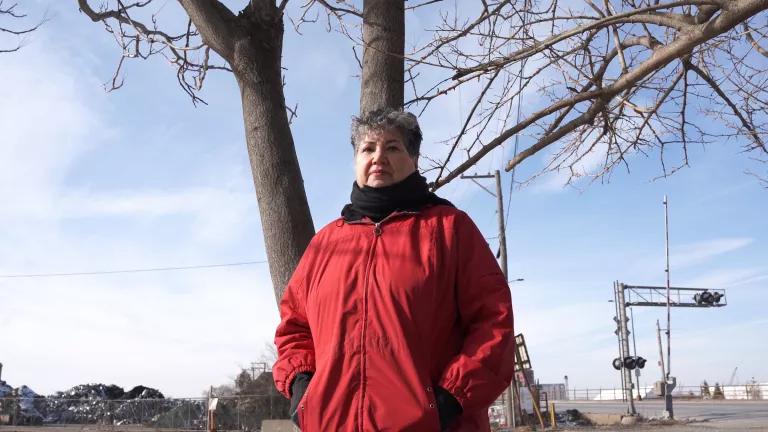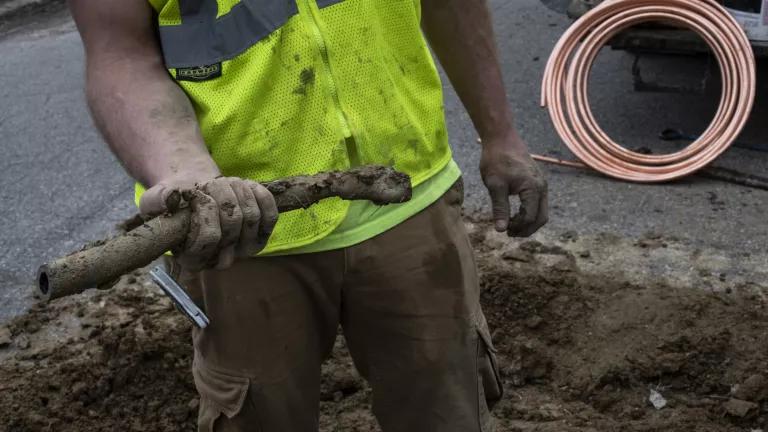Mining for Limestone on Chicago’s Southeast Side? Residents Gear Up for a Fight (Again).
A proposal to build an underground facility on a contaminated lot is yet another reason the city needs to address the cumulative impacts of industry on communities.

Peggy Salazar, former executive director of the nonprofit Southeast Environmental Task Force and a longtime resident of Southeast Side, poses for a portrait near the 106th Street bridge in southeast Chicago.
Sebastián Hidalgo for NRDC
On a 140-acre property on Chicago’s Southeast Side, spindly plants sprout from a hard-packed surface. Trees stretch skyward in another section of the lot, an area just beyond a Little League diamond’s left field. A residential neighborhood next to the property extends east to the Indiana state border just a few blocks away. To the west, the East Side neighborhood nearly reaches the Calumet River.
Like so many sites along this stretch of the river, this brownfield has a toxic history, contaminated decades ago by the steel companies that once operated in the area, then abandoned. And now, like so many times over the years, local residents are on the watch for new polluters trying to come in. For instance, a company called Ozinga Ventures wants to build a huge warehouse of sorts on the property—or peculiarly, 350 feet beneath it. The 6-million-square-foot underground facility, the company says, could house a range of businesses: a vertical farm, cloud computing operations, and light manufacturing, among others.
Before Ozinga Ventures seeks the necessary permits from the city, it has been trying hard to win over the community—putting its name on the baseball field next to the lot, holding public meetings about the proposal, and setting up a permanent office in the area (an unusual step for a company that has yet to start construction). Ozinga promises a project that will revitalize the plot, supply jobs, and strengthen the community.
Not everyone is buying it.
A mine by any other name

A view of Indiana industrial facilities from Wolf Lake in Chicago
Sebastián Hidalgo for NRDC
To create the warehouse, Ozinga Ventures—whose primary investors are the Ozingas, the family who runs the Ozinga concrete company—plans to blast and excavate limestone, an essential ingredient in concrete. The process—from the first blast to the last haul of limestone to the surface–would take roughly 13 years.
To many local residents, however, that sounds a whole lot like mining—an activity prohibited within city limits. A 2021 ordinance passed by the Chicago City Council regulates the construction and expansion of facilities that contribute to air pollution, and it includes a ban on new mining operations.
Company officials say that building the facility, dubbed “The Invert,” underground relinquishes them from any responsibility to clean up the land on the surface, an expensive endeavor. Though Ozinga Ventures has conducted its own environmental assessment on the site, it has not yet released its findings.
Calling the facility a warehouse is just a way to get around the mining ban and avoid footing the bill for remediation, says Peggy Salazar, a Southeast Side resident and former executive director of the nonprofit Southeast Environmental Task Force (SETF). “They’re claiming they’re going underground because the land above is so contaminated,” she says. “Well, if you really cared about the community, clean up the property and then build something. Don’t skirt the issue by going underground, profiting, and leaving all the contamination as is.”

A rusty-colored smoke emits odors of oil and dust form the Cronimet USAstainless steel scrapyards in southeast Chicago.
Sebastián Hidalgo for NRDC
A steady stream of pollution along the Calumet River
Of Chicago’s 26 industrial corridors, only the Southeast Side is zoned to store hazardous waste. According to the U.S. Environmental Protection Agency, the three neighborhoods surrounding the Ozinga property—East Side, Hegewisch, and South Deering—are also the three neighborhoods in the city that lie closest to several Superfund sites, which are areas deemed so contaminated with toxic waste that they require long-term, often government-funded, cleanup.
“I look at the whole plan of Chicago,” says concrete worker and Southeast Side resident Jim Kenny. “When you have a big city like this, is it fair to use one area as a dumping ground and do whatever you want environmentally?”

Jim Kenny, a concrete worker and Southeast Side resident near the 106th Street bridge in southeast Chicago.
Sebastián Hidalgo for NRDC
More than 150 industries line the Calumet River and its canals in this corner of Chicago. Since the steel industry left in the 1990s, the predominantly Black and Latino local community has had to fight proposal after proposal of polluters seeking to pick up where the steel industry left off. Community groups have successfully foiled some projects and have insisted on improvements from those that remain, such as pushing KCBX, a Koch brothers’ company, to move huge mounds of petcoke from the banks of the river. The black dust—a by-product of oil refining—degraded air quality and blew onto homes and playgrounds. In 2014, community groups also opposed a cement kiln proposed by Ozinga Bros. (yes, those same Ozingas) that would have emitted particulate air pollution, which increases risks for lung disease, heart attacks, and many other health problems.
More recently, concerned residents and nonprofits like SETF came together to oppose General Iron in its attempt to relocate a metal shredding operation from the tony Lincoln Park neighborhood. The city denied the permit last February, thanks in large part to community opposition, but the company is appealing the decision. So, as that fight drags on, a new one has already emerged just down the street with the Invert project.
“It never ends,” says Salazar. “We have to always be on guard. We have to be monitors and guardians, and it just doesn’t make sense to us. Who else lives like that in the city?”

Marie Collins-Wright at Wolf Lake on Chicago’s Southeast Side
Sebastián Hidalgo for NRDC
The industries that operate along the corridor rarely, if ever, take the community’s interests into account, says Marie Collins-Wright, who works with the Alliance of the Southeast. The Invert proposal “has absolutely zero benefit for the community that I can see,” she says. “I can’t think of anything good to say except they have a really nice presentation that they offer people who don't know any better.”
Stopping the revolving door of polluters
Advocacy groups are gearing up to fight Ozinga just as they did General Iron. An environmental assessment conducted during the latter fight showed that a third of all toxic air releases in Chicago were coming from just eight facilities on the Southeast Side. The Invert project would only worsen that air quality, with dust billowing from the underground construction and additional tailpipe emissions from thickened truck traffic through the neighborhood.

Traffic becomes dense along Torrence Avenue as newly made Ford cars mix with traffic in southeast Chicago.
Sebastián Hidalgo for NRDC
The advocacy groups are pushing the city to deny Ozinga its permits when the time comes, but that’s not all they want. In 2020, People for Community Recovery, a nonprofit working to improve the quality of life in a neighborhood known as the “toxic doughnut,” linked up with other community-led advocacy groups. Together, they sought to “change things at the root of the problem, which is systemic racism,” says Southeast Side resident Gina Ramirez, who serves as a Midwest outreach manager at NRDC and as board president of the SETF. The groups filed a complaint with federal housing officials saying that Chicago has pushed polluting industries into Black and Latino communities. In 2022, they formed the Coalition to End Sacrifice Zones to compel city and state officials to consider the cumulative effects of polluting industries on neighborhoods when evaluating new projects.
A year prior, Chicago Mayor Lori Lightfoot promised a city ordinance focused on environmental justice. Such a law would require a cumulative-impacts analysis when an industrial operation applies for a permit, but Lightfoot has yet to act on it. The advocates say other large cities, like Los Angeles and Minneapolis, have laws and regulations in place that address such snowballing consequences of additional dirty industries, particularly as they relate to the health of Black and Latino communities, and Chicago should be no exception. Progress on this front at the national level could come in the form of the Environmental Justice for All Act, but the legislation is currently stalled in Congress.

Industrial facilities including major railroads, stainless steel recycling yards, and more are in close proximity to residential homes and business in southeast Chicago.
Sebastián Hidalgo for NRDC
Meanwhile, the coalition is advocating for the Environmental Justice Act in the Illinois legislature, a bill that would require the Illinois Environmental Protection Agency to consider the testimony of community members who may not support a project, in a so-called third-party review, in air permitting. Recently, New Jersey lawmakers passed a similar law—legislation that’s now considered to embody the country’s strictest environmental justice rules for permitting. Though the Illinois bill failed to pass the state senate last year, the coalition is hopeful that lawmakers will take it up again this session.
“We’re trying to pass a state law, and we’re trying to pass a city law,” says Ramirez, “so that these companies don’t have the audacity to even think that they could try to pollute here.”
This NRDC.org story is available for online republication by news media outlets or nonprofits under these conditions: The writer(s) must be credited with a byline; you must note prominently that the story was originally published by NRDC.org and link to the original; the story cannot be edited (beyond simple things such as grammar); you can’t resell the story in any form or grant republishing rights to other outlets; you can’t republish our material wholesale or automatically—you need to select stories individually; you can’t republish the photos or graphics on our site without specific permission; you should drop us a note to let us know when you’ve used one of our stories.
Chicago has more lead service lines than any city in the country.
Urge Mayor Johnson to replace Chicago’s toxic lead service lines and protect residents!


In a Segregated Chicago, Art Puts Environmental Racism on Display
Environmental Justice in Chicago: It’s Been One Battle After Another
The Particulars of PM 2.5